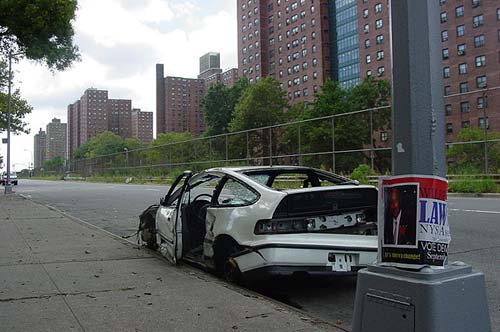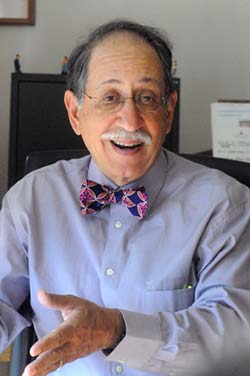 |
Among the neighborhoods in which Martín Sánchez-Jankowski spent most of the 1990s was the South Bronx, one of whose massive public-housing projects is pictured here. |
Cracking the chronic-poverty code
Living in housing projects for nearly a decade, Berkeley ethnographer Martín Sánchez-Jankowski discovered a ‘subculture of scarcity’ that resists middle-class values but makes the lives of the poor richer
| 22 October 2008
BERKELEY — Martín Sánchez-Jankowski earned his Ph.D. in economics and political science at MIT, working alongside such star students as Ben Bernanke and Paul Krugman. All went on to distinguished academic careers — Bernanke and Krugman at Princeton, and Sánchez-Jankowski, after stints at Wellesley College and the University of New Mexico, in the sociology department at Berkeley. But that’s where the similarities end.
Bernanke, now the Federal Reserve chief, passes his days consorting with captains of government and industry in an effort to ward off global financial collapse. Krugman, an op-ed columnist for The New York Times and increasingly in-demand TV talking head, will fly to Sweden in December to pick up his 2008 Nobel Prize in Economic Sciences.
 Martín Sánchez-Jankowski (Peg Skorpinski photo)
Martín Sánchez-Jankowski (Peg Skorpinski photo)
![]() Video: Cracks in the pavement: Social change and resilience in poor neighborhoods from the Center for Latino Policy Research
Video: Cracks in the pavement: Social change and resilience in poor neighborhoods from the Center for Latino Policy Research
Sánchez-Jankowski, by contrast, is apt to be found — should anyone care to follow him — surrounded by violence and poverty, whether he’s hanging with inner-city gangs or sleeping in native huts on the outer islands of Fiji. He spent most of the 1990s living in housing projects in five chronically poor neighborhoods in New York and Los Angeles, documenting what he calls the “subculture of scarcity” for the recently published Cracks in the Pavement: Social Change and Resilience in Poor Neighborhoods (UC Press).
What he discovered was that the poor, to paraphrase F. Scott Fitzgerald, are different — albeit not in the ways that other sociologists (and many political conservatives) have argued for decades. Impoverished neighborhoods, Sánchez-Jankowski learned, exhibit a fierce sense of self-preservation, constantly reinforcing values that serve to maintain the status quo while protecting against those that threaten their local culture, whether the source is state agencies seeking to impose order or foreign immigrants who bring their alien cultures into public-housing projects.
It’s not that the poor don’t aspire to status and material wealth, in his view. But due to the perception that they’re less likely to achieve them in the ways that middle-class people do — via well-paying jobs, for example — residents of poor neighborhoods are more apt to embrace, or at least tolerate, the underground economy. Similarly, absent the level of social services on which middle-class people regularly depend, gangs and other local institutions often step up to play a constructive role in low-income communities.
“This pervasive notion about disorganization leading to deaths, leading to all kinds of social problems — that it’s the inability of people to solve local problems that constitutes disorganization — is something that I found to be just not empirically true,” declares Sánchez-Jankowski, a self-described “participant-observer” who directs the campus’s Center for Urban Ethnography. Over the course of nine years in the 1990s — or 20 days shy of five years, as measured in actual man-hours — he insinuated himself into the fabric of the neighborhoods he chose to study, assiduously chronicling how such institutions as housing projects, gangs, high schools, mom-and-pop stores, and barber shops and beauty salons serve as agents of either change or preservation.
To his surprise, he found the neighborhoods — pockets of the South Bronx, the East Bronx, Brooklyn, East Los Angeles, and L.A.’s South Central where at least half the population had had incomes under the poverty level for 25 years or more — remarkably dynamic and well-organized. He also found much to admire about the moral and social values that those from other socioeconomic strata — school administrators, state bureaucrats, and middle-class people generally — might view as unproductive or even self-destructive.
Rather than a rejection of mainstream values, he says poor residents’ embrace of the “subculture of scarcity” helps them to cope with “a series of problems that the outside world never gets to see,” and to infuse lives of material scarcity with meaning.
Before he began his study, Sánchez-Jankowski accepted the prevailing wisdom of his discipline — “that disorganization was the major modus vivendi of poor neighborhoods, and that the indication of this was high amounts of crime, vagrancy, litter, drug and alcohol consumption in public areas, and that these were both a sign of disorganization and a contributor to it.”
“But it’s simply not true,” he realized. “I guess that was the most astounding thing to me.”
Mismatch of values
“I admire the effort people make to maximize the potential for their lives with limited resources,” allows Sánchez-Jankowski, the son of itinerant farmers who spent his earliest years in a native Mexican village — his first language is Yaqui, his second Spanish — and later grew up in poor sections of Texas and Michigan. (The latter half of his surname comes from his adoptive father.) Admiring the poor, however, does not mean romanticizing them.
“I think the book tells you quite clearly that there are many things that help them to live a meaningful life, and even a productive life, within certain confines, that to the outside world would not merit the terms ‘productive’ or ‘meaningful,’ ” he says. “And in pursuing those, they actually limit their chances of getting a better life.”
That’s why, if policymakers are serious about reducing poverty, it’s essential that they first understand the role that local institutions — including gangs — can play in preserving the social structure of poor neighborhoods, and the regard in which they are held by residents, despite the judgments of those on the outside looking in.
Gangs and shootings in poor neighborhoods, he argues, are not inherently different from chronic problems in more affluent ones. “One has to manage this as part of the environment,” suggests Sánchez-Jankowski, “in the same way that I’d say people in the middle class have to manage drug abuse, for example, as part of the environment. Now, would they both be better off without these problems? Yes.
“But if you said to me, we will have no crime, no shootings at all in lower-class areas, and everything will look clean in these areas, would this alter the fundamental basis of their existence? And there I think the evidence is very clear: No.”
Efforts to persuade residents of poor neighborhoods to adhere to middle-class standards — including the “proper” behavior enforced by high schools and other institutions that are “in the neighborhood, but not of the neighborhood” — are doomed to fail, asserts Sánchez-Jankowski. If policymakers hope to reduce poverty, he believes, they need to look at how to “disrupt the natural environment that allows it to grow.” For starters, that means breaking up subsidized-housing projects, which isolate the poor and serve as Petri dishes for the “subculture of scarcity.” Even in times of relative prosperity and economic opportunity — as during the Clinton era, when Sánchez-Jankowski conducted most of his research — culture trumps incremental improvements in material wealth.
“One argument of this book is that the idea that poor people are just average people without money is just not right.” he says. “There is something that they’ve developed over the years in order to deal with this condition that makes them substantively different in their outlooks in a way that money couldn’t affect.”
The core of the problem, he continues, is “a mismatch between the values being generated at the lower classes and those being generated in the middle.” Without an appreciation for the values that keep poor neighborhoods poor, he insists, we’ll never end long-term poverty.
“That’s something we’ve always been struggling with in America,” he says, “and we haven’t had a very good battle plan or calculus for how to do that.”
Up from poverty, and back
For Sánchez-Jankowski, as for countless individuals before him, education offered a way out of poverty. For him, however, education was a two-way street, providing not just an escape from poverty but a reason to keep returning.
“I’m from that background,” he says in his office on the third floor of the Survey Research Center, a ramshackle building that in the 1890s was home to the Anna Head residency school for girls. “But like all kids from that background, I wanted to get out. And the time that I was growing up was a time in America when getting out was possible.”
He leveraged his athletic prowess to go to college, then “went back and taught high school and junior high school in Detroit, in the same kind of neighborhood that I’d previously lived in. And I found myself saying, ‘All right, I went to college, I studied and all that, and now I’m right back where I started from.’ And that was really disconcerting to me.”
It wasn’t until he’d been to MIT — in the same program as Henry Brady, now the head of the Survey Research Center — that his attitude changed, and he set his sights on understanding the dynamics of poverty.
“I was interested in political and economic development,” Sánchez-Jankowski recalls. “And when you’re dealing with economic development, you’re interested in the poor.”
He took part in a project that dealt with migrants moving to cities in Mexico. “Some of the analyses that I used in my own research weren’t fitting out with the data that was being generated,” he remembers. “And so someone asked me if I would go down and look to see how things were working out in everyday life. I did, and I made a report back, and we made corrections.
“And that,” he declares, “was the bug that bit me.”
Surrounded by people “gifted in math,” Sánchez-Jankowski explains, he realized that crunching numbers was only part of the story: “What we also had to understand is how things get worked out in the larger sense, so we know both the magnitude of the problems — which we do via math — and the mechanisms by which those things we’re concerned about get worked out in everyday life.”
It was that revelation, he says, that made him an ethnographer, and led him, among other studies, into a decade-long examination of 37 urban gangs in L.A., New York, and Boston – an endeavor aided somewhat by his skill in martial arts, but more by a talent for winning the trust of research subjects from a multiplicity of ethnic, cultural, and national backgrounds. The results of that research were published in Islands in the Street, a book he says sparked controversy for its findings — no longer in much dispute — that gang members were “rational actors,” and that gangs’ relationship to the community “was neither parasitic nor tyrannical.”
He’s currently writing two more books — one on the dynamics of school violence between blacks and Mexican-Americans, the other on the obstacles poor kids face getting through high school. As always, when he isn’t writing or teaching, he’s back in the field, researching his next project — at the moment, a comparative study of poverty among indigenous people in Fiji and in three Native American tribes.
“There are a lot of hazards,” admits Sánchez-Jankowski, who’s withstood beatings, disease, broken bones, and all manner of hardship in the pursuit of ethnographic insight. “It’s hard, but I enjoy field research. I enjoy the interactions with people.
“I am glad,” he adds, “to come home.”

